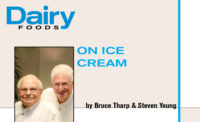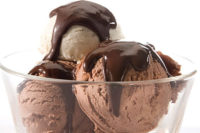What needs to be considered when coloring ice cream? Color is almost always added to frozen desserts to enhance the visual appeal of the finished product.
What needs to be considered when coloring ice cream? Color is almost always added to frozen desserts to enhance the visual appeal of the finished product. In some instances, no additional color may be necessary or desirable (for example, when using pure vanilla extract, cocoa powder, fruits or egg yolk solids). In any case, the color of the finished product must be compatible with the dominant flavor of the product.
It is important to note that color can be lightened by factors that increase the number of particles that reflect light. Those factors include increasing overrun and reduction in air bubble size, increased levels of naturally occurring casein micelles and decreasing the size of fat globules.
Beyond color due to mix ingredients (milk fat, casein micelles, vanilla, egg yolk solids, cocoa and others) and colors added from inclusions (fruit, fruit juices and the like), exempt colors (so-called “natural”) and non-exempt (artificial) colors can be added to frozen desserts. As long as the colors are generally recognized as safe (or GRAS), this is allowable.
Color is affected by the following factors:
Amount and type of color. It is obvious that adding more or less color can be critical to sensory appeal. In addition, whether a color is natural or artificial can affect color stability and, ultimately, the color of the finished product across its shelf life. Unlike many exempt colors, non-exempt ones yield extremely accurate, precise and stable colors.
Color and composition of mix. Variables in the levels of fat, total solids, type of milk-solids-not-fat, specific ingredients and others can affect the color of any given mix.
Ingredient selection. The color of mix ingredients themselves (for example, egg yolk) can alter the color of any mix. In addition, the nature of the color (the color extract) and the nature of the mix can cause color variability.
Processing. High-temperature treatment of ingredients or the mix itself can darken the mix and thus detract from the shade and brightness imparted by any given color.
Marketing needs. Market requirements can dictate particular amounts, shades and types of colors used. Ice cream processors must take care to select the proper amount and type of colorant to add to meet market expectations for any given flavor.
Regulatory limitations. The use of colors must be restricted to those that are GRAS or be an approved food additive.
Finished weights. As the amount of air is increased and air cell sizes are reduced, the finished product will lighten in color. This means that the level and/or type of added color might have to be increased or modified to provide the exact color desired.
Color stability. Typically, artificial colors (non-exempt colors) are most stable, although when bleached, they tend to lose color completely. Natural colors or extracts used as sources of color are typically labile to physical and chemical processes. These can include oxidation/reduction reactions, pH changes, microbiological growth, heat-induced changes and exposure to light.
Uneven color. When color is added at the flavor tank or via injection of inclusions, streaking and “bleeding” across the frozen dessert can occur. This is unsightly and may not reflect the true nature of the product. If bleeding becomes excessive, the final product may fail to show discrete separation of an inclusion and the mix. Also, mottling can be produced when streams of product from two or more freezers are blended before packaging, due to variation in the color of the mix or in the level of overrun. The effect of such variations can be avoided by use of an in-line mixer that thoroughly blends the multiple streams.
Unnatural. Unnatural color is any color that may not be compatible with the characterizing flavor. For example, dark gray or dark red may be deemed “unnatural” if the frozen dessert is meant to be a strawberry-type product requiring more bright red color.
Whatever type or level of color is used in whatever mix, color plays an important role in the perception of flavor. Any compromise on color puts both visual appeal and flavor at risk. Thus, care in selection of the right amount and type of color is critical to success.
Bruce Tharp is principal of Tharp’s Food Technology, Wayne, Pa. Steve Young is principal of Steven Young Worldwide, Houston.
For more on colors and colorants in ice cream and other frozen desserts, join Bruce Tharp and Steven Young at Tharp & Young on Ice Cream Technical Short, Workshops and Clinics, Nov. 30-Dec. 2 in Las Vegas. Go to www.onicecream.com or call 610-975-4424 or 281-596-9603.
Get our new eMagazine delivered to your inbox every month.
Stay in the know on the latest dairy industry trends.
SUBSCRIBE TODAYCopyright ©2024. All Rights Reserved BNP Media.
Design, CMS, Hosting & Web Development :: ePublishing


